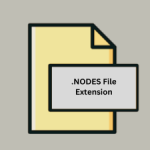.OMF File Extension

Open Media Framework File
| Developer | Avid Technology |
| Popularity | |
| Category | Audio Files |
| Format | .OMF |
| Cross Platform | Update Soon |
What is an OMF file?
The Open Media Framework (OMF) file extension is a significant and versatile format in the world of digital media production.
This file format, often seen with the .omf extension, is primarily used to simplify the process of sharing multimedia projects across different software platforms.
It’s a format that’s commonly employed in the post-production stages of film, television, and audio production.
The OMF format serves as a container, holding various types of media data, including video, audio, and effects, allowing for efficient project exchange between editors, sound designers, and other post-production professionals.
More Information.
Initially released in the early 1990s, the OMF file format was revolutionary in fostering collaboration within the post-production process.
Before the advent of OMF, sharing project data between different editing systems was a cumbersome and error-prone process.
OMF was designed to encapsulate a project’s media alongside its associated metadata, making it a robust solution for transferring complex projects between different systems and software.
Origin Of This File.
The OMF file was developed by Avid Technology, a leader in the field of digital non-linear editing. The company introduced the format to address the need for a standard method of exchanging project data between different software systems and platforms.
The idea was to create a file format that could maintain the integrity and structure of a multimedia project, regardless of the software used to create or modify it.
File Structure Technical Specification.
An OMF file is essentially a container that can include various types of media files and their associated metadata.
The file structure is designed to be both flexible and comprehensive, ensuring that essential project information (such as track names, clip names, in and out points, and volume levels) is preserved when transferring between systems.
Technically, OMF files can be of two types, OMF Interchange (OMFI), which is a more compact version suitable for simple projects, and OMF Composition (OMFC), which is more complex and can handle elaborate projects with numerous media assets and effects.
The format supports embedded media (where the media files are included within the OMF file itself) or external media (where the OMF file references media stored in separate files).
How to Convert the File?
Converting an OMF (Open Media Framework) file typically involves using a digital audio workstation (DAW) or video editing software that supports the OMF format.
The process may vary slightly depending on the specific software you’re using, but generally follows a similar workflow.
Here’s a step-by-step guide on how to convert an OMF file to another format using common audio and video editing software:
1. Choose the Right Software:
First, you need software that can handle OMF files. Popular choices include:
- Avid Media Composer (for video)
- Adobe Premiere Pro (for video)
- Pro Tools (for audio)
- Logic Pro X (for audio, with some limitations)
2. Import the OMF File:
- Open your software and choose to start a new project.
- Look for an option to import or open an existing project.
- Navigate to the location of your OMF file and select it.
- The software may ask if you want to copy media files into your project folder or use them from their current location (if the OMF is referencing external media). Choose the option that best fits your project needs.
3. Review and Adjust the Imported Project:
- Once the OMF file is imported, review the project timeline to ensure all elements (audio tracks, video clips, etc.) are correctly aligned and that no data is missing.
- Make any necessary adjustments or edits.
4. Export to the Desired Format:
- After you’re satisfied with the project, look for the ‘Export’ or ‘Share’ option in your software. This is usually found under the ‘File’ menu.
- Choose the format you want to convert the OMF file into. Common formats include .wav or .aiff for audio, and .mov or .mp4 for video.
- Some software might offer advanced export settings where you can choose codec, quality, resolution, etc. Adjust these settings according to your needs.
- Choose the destination where you want to save the new file and start the export process.
5. Conversion Complete:
- Once the export process is complete, you will have a new file in the format you chose. It’s a good idea to play the file to ensure the conversion process didn’t introduce any unexpected changes or errors.
Advantages And Disadvantages.
Advantage:
- Compatibility: OMF supports a wide range of audio and video editing software, making it a universal choice for multimedia project exchange.
- Data Integrity: It maintains a high level of data integrity, ensuring that project details are not lost during the transfer.
- Efficiency: It streamlines the collaboration process, allowing different team members to work on the same project using different software tools.
Disadvantage:
- File Size: OMF files can be large, especially if they embed media, leading to storage and transfer challenges.
- Complexity: The format can be complex, and creating or modifying OMF files may require a deep understanding of the structure and the software used.
- Compatibility Issues: Despite its wide acceptance, some newer or less common software may not fully support the format, leading to potential workflow issues.
How to Open OMF?
Open In Windows
- Install Avid Media Composer.
- Open the application and start a new project.
- Go to ‘File’ > ‘Import’ and navigate to your OMF file to open it.
Open In Linux
Linux doesn’t have native support for many of the mainstream professional audio and video editing applications that typically open OMF files. However, you can:
- Use Wine to run Windows applications that support OMF files, like Avid Media Composer or Adobe Premiere Pro.
- Look for cross-platform DAWs (Digital Audio Workstations) or video editing software that might offer support for OMF files.
Open In MAC
For macOS, professional software options are available to open and work with OMF files:
- Avid Media Composer: A leading software in video editing that originally introduced OMF. It provides comprehensive support for OMF files.
- Logic Pro X (primarily for audio): While it may not support all features of OMF, it can be used for audio post-production.
Open In Android
OMF files are typically not used directly on Android devices due to their professional and complex nature. But can try this step:
- Some professional audio and video editing software may offer companion mobile apps to review projects and do basic edits.
- For detailed editing and manipulation, transferring the file to a desktop environment is recommended.
Open In IOS
- Companion apps for software like Avid Media Composer or Adobe Premiere Pro might provide some level of access or project management capabilities on iOS devices.
- Full editing capabilities would generally require a desktop-class application.
Open in Others
- Research: Look for any niche or specialized software that is designed to work on your specific system and supports OMF files.
- Conversion: Consider converting the OMF file into a more universally accepted format using a compatible application on a supported OS. Then, transfer the converted file to your device or system.













